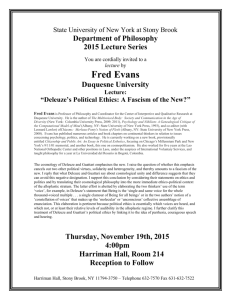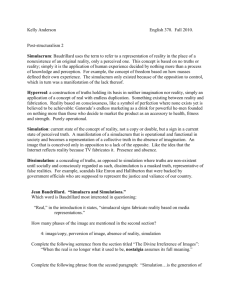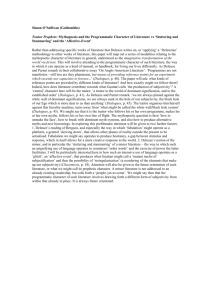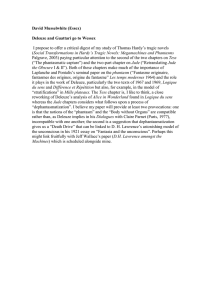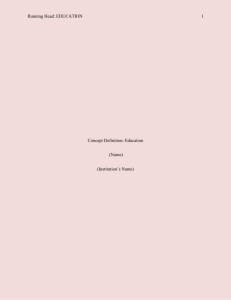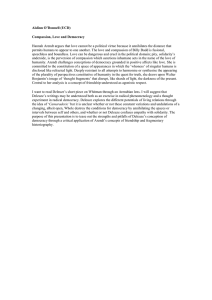Nomadic Flows: Globalism and the Local Absolute
advertisement
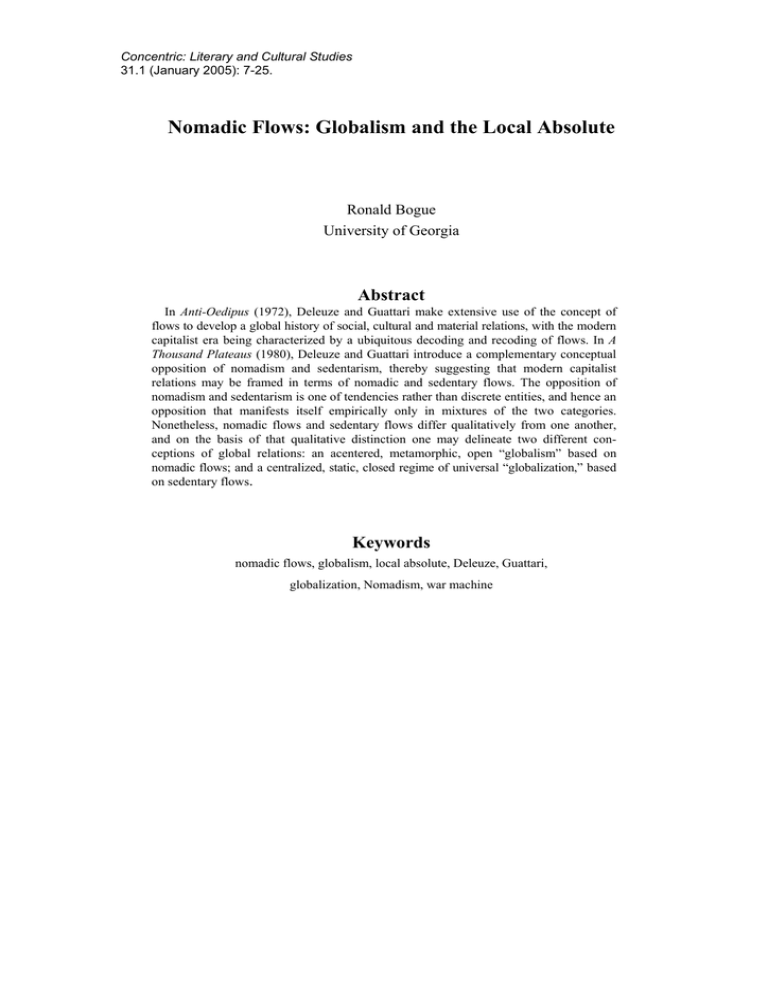
Concentric: Literary and Cultural Studies 31.1 (January 2005): 7-25. Nomadic Flows: Globalism and the Local Absolute Ronald Bogue University of Georgia Abstract In Anti-Oedipus (1972), Deleuze and Guattari make extensive use of the concept of flows to develop a global history of social, cultural and material relations, with the modern capitalist era being characterized by a ubiquitous decoding and recoding of flows. In A Thousand Plateaus (1980), Deleuze and Guattari introduce a complementary conceptual opposition of nomadism and sedentarism, thereby suggesting that modern capitalist relations may be framed in terms of nomadic and sedentary flows. The opposition of nomadism and sedentarism is one of tendencies rather than discrete entities, and hence an opposition that manifests itself empirically only in mixtures of the two categories. Nonetheless, nomadic flows and sedentary flows differ qualitatively from one another, and on the basis of that qualitative distinction one may delineate two different conceptions of global relations: an acentered, metamorphic, open “globalism” based on nomadic flows; and a centralized, static, closed regime of universal “globalization,” based on sedentary flows. Keywords nomadic flows, globalism, local absolute, Deleuze, Guattari, globalization, Nomadism, war machine 31.1 (january 2005) Few theorists have made as extensive a use of the vocabulary of flows as have Gilles Deleuze and Félix Guattari in their 1972 Anti-Oedipus: Capitalism and Schizophrenia. In this free-wheeling critique of psychoanalysis and vulgar dialectical materialism, Deleuze and Guattari envision a universe of ubiquitous flows and fluxes, processed by the connections, disjunctions and conjunctions of heterogeneous assemblages of desiring machines through which these flows circulate. Every machine, they assert, “is in relation with a continuous material flow,” and each flow “must be considered as an ideal thing, an infinite flux” (Anti-Oedipus 43-44 [36]).1 This figure of an oceanic cosmos of matter-flows allows Deleuze and Guattari to capture something of the schizophrenic logic of market capitalism, with its law of universal equivalence whereby anything may be exchanged for anything else. It also offers a kind of nightmarish vision of economic globalization, whose expanding fluxes of international capital wash across political, social, and cultural boundaries and threaten to drown the earth in a single homogeneous commercial sea. But Deleuze and Guattari do not offer this image of a universe of flows solely to critique capitalism, for they locate as well the possibility of creative transformation in the proliferation of interconnecting networks of flows. Yet this distinction between a positive and a negative use of flows, though developed at length in Anti-Oedipus, is not always easy to follow. The distinction becomes eminently clearer, however, if one conjoins the concept of flows with that of “nomadism” and its corollaries “smooth space” and “the war machine,” which Deleuze and Guattari treat at length in their 1980 sequel to Anti-Oedipus, A Thousand Plateaus: Capitalism and Schizophrenia. There, not only do they dif-ferentiate the nomadic from the sedentary, smooth space from striated space, the war machine from the State apparatus, but they also distinguish between two visions of a global whole, which they label the “relative global” and the “local absolute.” My goal in this essay is to make succinct the difference between a positive and a negative use of flows by examining closely the concept of “nomadism” and developing an opposition of nomadic flows and sedentary flows; and by so distinguishing nomadic and sedentary flows, to demarcate a negative process of globalization, whose logic is that of the “relative global,” from a positive process of acentered, interactive globalism, which is implicit in the concept of the “local absolute.” 1 All translations from Deleuze and Deleuze-Guattari are my own; all citations indicate French pagination followed by corresponding pages in the English translation. References to Mille plateaux (A Thousand Plateaus) are abbreviated as MP; those to Pourparlers (Negotiations) are abbreviated as PP. 8 Bogue: Nomadic Flows Nomads and Nomadic Distributions In A Thousand Plateaus, Deleuze and Guattari apply the concept of “nomadism” to a wide range of topics, including mathematics, physics, games, cloth manufacture, metallurgy, music, and art, but the core elements of the concept derive from observations about nomadic peoples. When speaking of “nomads” and “the nomadic” in this socio-anthropological sense, Deleuze and Guattari seem to play fast and free with traditional anthropological distinctions and to make sweeping assertions about nomadic populations that ignore the complexities of actual concrete groups. Anthropologists commonly differentiate between hunter-gatherers, pastoral nomads, and peripatetics, reserving the label of “nomads” for the five main groups of pastoral nomads—the African pastoralists of the Sahel, such as the Masai; the camel pastoralists of the Saharan and Arabian Deserts; the sheep and goat pastoralists of the region running from the Mediterranean littoral through the Anatolian and Iranian Plateaus into mountainous central Asia; the horse-riding nomads of the Eurasian steppe; and the yak breeders of the Tibetan Plateau (Barfield). Yet Deleuze and Guattari seem indifferent to such distinctions, citing as instances of nomadism traditional hunter-gatherer tribes of Africa and South America, various pastoral nomads, such as the Mongols and the Bedouins, the sea nomads of Patagonia, as well as peripatetics of diverse sorts— itinerant craftsmen, gypsies, street gangs, etc. And much of what they say about nomads seems applicable to one group only, or solely to a single aspect of one group’s behavior. Some critics have seen in this treatment of nomadism signs of sloppy scholarship and a romantic idealization of mobile populations, 2 but Deleuze and Guattari are in reality developing a concept of nomadism that deliberately cuts across traditional anthropological categories and extracts characteristics from actual social groups that are at times only intermittently and indirectly evident in those populations. Their object is to identify two broad tendencies—the nomadic and the sedentary—each of which has an inner coherence yet is manifest concretely only in various mixed forms. Crucial here is the distinction between observations de facto (of fact; French: en fait) and de jure (of law or right; French: de droit), a distinction Deleuze and Guattari take from natural law theory by way of Henri Bergson. Natural law philosophers of the medieval and early modern periods frequently observe that a despot or usurper of the 2 See Miller for an extended critique of Deleuze and Guattari’s “nomadism” along these lines. 9 31.1 (january 2005) throne may gain power and hold sway de facto, “in fact,” but only a legitimate sovereign may rule de jure, that is, in accordance with natural law. Hence, rule de jure comes to mean not simply rule “by law or right,” but also rule “by nature,” or in accordance with the nature of things. Bergson appropriates this opposition for his own purposes to distinguish between empirical mixtures of elements, which exist de facto, en fait, and differences de jure, en droit, or differences of nature. Bergson’s various dualisms—such as duration/space, quality/quantity, and matter/memory—identify differences in nature, en droit, that only appear in a mixed form in empirical experience (en fait). As Deleuze observes, “According to Bergson a composite [un mixte] must always be divided according to its natural articulations, that is, into elements which differ in nature. [...] Bergson is aware that things are mixed together in reality, in fact; experience itself offers us nothing but composites” (Bergsonism 11-12 [22]). Bergson often speaks of pure memory or pure duration, and in so doing he is speaking of differences in nature that are only manifest de jure, not de facto. As Deleuze notes, “If the composite represents the fact, it must be divided into tendencies or into pure presences that only exist en droit” (Bergsonism 12 [23]). Bergson observes, for example, that we tend to perceive time in a spatial manner, thinking of each moment as a point on a geometric line. As a result, we confuse time and space, mixing the two, and thereby fail to grasp the true nature of temporal duration as ongoing, indivisible movement. Only by delineating a pure duration and a pure space may we understand the true nature of time. In our everyday experience, time and space are always mixed together, but de jure time and space constitute a difference in nature, a difference marked by tendencies toward pure forms that are never experienced de facto, in fact. As Deleuze and Guattari indicate at several points in A Thousand Plateaus, their opposition of the nomadic and the sedentary is a de jure distinction of pure differences in nature. The nomadic and the sedentary are qualitatively distinct and real categories, but they are experienced in fact only as tendencies within various mixed states. Hence, Deleuze and Guattari would have no difficulty explaining sedentary proclivities within nomadic populations or the patent appearance of certain nomadic characteristics solely within certain groups and not within others. In each case, a de jure difference in nature is manifest only in a de facto mixture. Deleuze and Guattari’s most extended treatment of nomadism is to be found in A Thousand Plateaus, but as early as 1969 Deleuze engages certain elements of the topic in Difference and Repetition. There, he attempts to characterize being in terms of multiplicities that are irreducible to a dialectic of the One and the Many, and he does 10 Bogue: Nomadic Flows so through the concept of a “nomadic distribution” of elements. In reflecting on the notion of the nomadic, Deleuze finds particularly illuminating Emmanuel Laroche’s 1949 study, History of the Root “Nem-” in Ancient Greek, an exhaustive treatment of the family of ancient Greek words that includes nemo, nemao, Nemesis, nomos, nomas, and other cognates. In classical Greek of the fifth century B.C.E., nomos generally means “law” or “custom,” and Nemesis refers to “Fate.” Laroche observes that scholars traditionally attribute these meanings to an archaic sense of nomos as a partitioning and assigning of lands to various parties and of Nemesis as an allocation of separate lots, or fates, to individuals. Laroche counters that the etymological history is much more complex than this account would indicate. The key to that etymological history he finds in the eighth century B.C.E. Homeric usage of the verb nemo, which he translates as “to distribute.” The actions of “dividing into parts” and “distributing” are related in the Homeric world, as when a warrior carves a roasted lamb into parts and then distributes pieces to his comrades, but nemo refers solely to the act of distributing. The Homeric sense of nemesis is not that of fate, but that of an imputation of blame, which derives from the concept of nemesis as an improper distribution of elements. The sense of nomos as law or convention Laroche sees as a late development, with the archaic sense of nomos coming from the usages associated with pasturage and nomads. In Homer, nomos designates a place where animals graze. “Pasturage in archaic times,” notes Laroche, “is in general an unlimited space; it can be a forest, meadows beside rivers, a mountain slope” (116). Archaic nomos in no way indicates a partitioning of land. Later, after the reforms of Solon, nomos comes to mean “assigned plot of land,” but this usage reflects an extension of city sedentary divisions to the surrounding countryside. In archaic times, by contrast, if the nomos is related to the city, it is as “an expanse of habitable land around a city before being an administrative province” (Laroche 117). Laroche concludes then that “nomos designates nothing other than pasturage for animals or a habitat without recognized limits for men” (117). The archaic term nomas, Laroche points out, designates either a nomadic herdsman or a herd animal, a nomadic herdsman being characterized as a wandering individual with no fixed domicile, and a herd animal as a creature that moves freely and randomly across an open territory (122). What Deleuze takes from Laroche’s study is the notion of nomos as a distribution of multiple elements in an open, undivided, and unlimited space. In Difference and Repetition, Deleuze describes being in terms of a “nomadic distribution,” a distribution of an irreducible multiplicity that “is no longer a division of that which is distributed 11 31.1 (january 2005) but rather a division among those who distribute themselves in an open space—a space that is unlimited, or at least without precise limits” (54 [36]). In A Thousand Plateaus, Deleuze and Guattari do not attempt a description of all being as a “nomadic distribution,” as Deleuze does in Difference and Repetition, but they do make use of the archaic Greek notion of nomos in developing the concept of “nomadism.” They cite Laroche and oppose the nomadic to the sedentary as the archaic Greek nomos of open pasturage to the partitioned territory of the city. And whenever they speak of the nomadic they conceive of it as a multiplicity distributed in an open space. One model of the nomadic, then, is that of a flock of sheep occupying an undivided landscape. The flock wanders over undulating surfaces, filling the contours of valleys, plains, hillsides or slopes, in each case occupying space to the extent of its capabilities, its puissances or powers. The configuration of relations among individual sheep shifts and changes, and the shape of the collective flock is in constant metamorphosis, adapting itself to the variations in the topography of the landscape. As the flock roams, it continually exceeds the limits of its external outlining edges, filling new space as it leaves previously occupied territory. The flock is a flow, a flux of multiple elements engaged in an ongoing metamorphic, dynamic process of nomadic distribution across an open and undivided space. Before proceeding to Deleuze and Guattari’s definition of nomadism, we should note two important characteristics of the multiplicities involved in a nomadic distribution of elements. First, the multiplicities are qualitative multiplicities. In his book Bergsonism, Deleuze credits Bergson with being the first philosopher to differentiate clearly between quantitative and qualitative multiplicities. Quantitative multiplicities are collections of elements that do not change their qualities when increased or decreased through addition, subtraction, multiplication or division. Five bricks plus five bricks equal ten bricks, but whether a collection of five bricks or a collection of ten bricks, the multiplicity remains a collection of bricks. Qualitative multiplicities, by contrast, cannot be increased or decreased mathematically without being changed qualitatively. A room at a temperature of sixty degrees may be heated to a temperature of ninety degrees, but the multiplicity of the room at sixty degrees is qualitatively different from the room at ninety degrees. One cannot add sixty degrees to thirty degrees without creating a new qualitative multiplicity of ninety degrees, one that is incommensurable with any quantitative summation of sixty and thirty. All nomadic multiplicities are such qualitative multiplicities. In this regard, each nomadic multiplicity has an identity, but an identity that is irreducibly multiple and open to 12 Bogue: Nomadic Flows metamorphosis as its constituent elements increase or decrease. In that its identity is formed through its qualities, each multiplicity also possesses a certain affectivity. Second, nomadic multiplicities constitute what Deleuze and Guattari call “rhizomes.” In A Thousand Plateaus, they oppose rhizomes to “arborescences,” or root-tree structures. Unlike arborescences, which have a vertical, hierarchical, and centralized configuration, rhizomes are horizontal, nonhierarchical formations with no center. Deleuze and Guattari liken rhizomes to crabgrass, which spreads in all directions and extends roots along every surface it occupies. There is no central root, no privileged locus of growth. Any patch of crabgrass, if uprooted and transplanted, may initiate a renewed process of growth and expansion. Not only is the rhizome nonhierarchical and acentered, but it also manifests what Deleuze and Guattari call “the principles of connection and heterogeneity: any point of a rhizome can be connected to any other point whatever, and must be” (MP 13 [7]). The rhizome, then, has no center, no hierarchical organization, and no stable patterns of interconnection among its elements. The rhizome, we might say, is a network much like the Internet (which only came into being after Deleuze and Guattari developed the concept of the rhizome), a proliferating multiplicity of terminals and circuits, in which any terminal may be connected to any other terminal, and with such rapidity that each terminal is virtually contiguous to every other terminal, no matter how far apart the various terminals may be in terms of actual spatial distance. We may thus make the following preliminary summary of the characteristics of a nomadic multiplicity: it spreads over an unlimited and undivided space as a metamorphic flux; it constitutes a qualitative multiplicity with an identity that is irreducibly plural and affective; and it forms a rhizome, without center or hierarchy, in which each element is in virtual contiguity and connection with every other element. Nomadism, Smooth Space and the War Machine In A Thousand Plateaus, Deleuze and Guattari define nomadism through two complex concepts: the war machine and smooth space. The relationship between nomadism, the war machine and smooth space is expressed in an especially succinct (albeit cryptic) manner in the following comment made by Deleuze in a 1980 interview on A Thousand Plateaus: 13 31.1 (january 2005) we define the “war machine” as a linear assemblage which constructs itself on lines of flight. In this sense, the war machine does not at all have war as its object; it has as its object a very special space, smooth space, which it composes, occupies and propagates. Nomadism is precisely this combination “war machine-smooth space.” We try to show how and in what case the war machine takes war for its object (when the apparatuses of the State appropriate the war machine which does not initially belong to them). A war machine tends to be revolutionary, or artistic, much more so than military. (PP 50-51 [33]) First let us examine the notion of “smooth space.” Deleuze and Guattari oppose smooth space to striated space, identifying smooth space as “nomad space [...] the space in which the war machine develops,” and striated space as “sedentary space [...] the space instituted by the State apparatus” (MP 592 [474]). The opposition seems quite simple: smooth space is space undivided and unmeasured, whereas striated space is crisscrossed with grids of dividing and measuring lines. But the distinction is more complicated than it might initially appear. First, it is a de jure distinction, as Deleuze and Guattari explicitly state: “the two spaces only exist in fact in mixtures of one another: smooth space is ceaselessly translated, transversed into striated space; striated space is constantly reversed, turned into a smooth space [...] and the two can happen at the same time. Yet the de facto mixtures do not impede the de jure distinction, the abstract distinction between the two spaces” (MP 593 [474-75]). Second, the distinction is not strictly spatial. In fact, Deleuze and Guattari take the opposition of smooth space and striated space from the composer Pierre Boulez, who uses the terms to describe different forms of time in musical compositions, smooth space characterizing the unpulsed time of free, irregular motifs, and striated space the pulsed time of regular, metrical motifs. Thus, Deleuze and Guattari describe literal space in terms of the smooth and the striated, but they extend the concepts as well to such figurative spaces as music, art, and mathematics. Third, and most important, “smooth” and “striated” describe not simply space per se, but also ways of inhabiting and using space, and in this sense, ways of creating a smooth or a striated space. In Deleuze and Guattari’s discussion of the maritime model of smooth space, the de facto mixture of smooth and striated spaces is especially evident, as is the relationship between space and its usage. They note that though “the sea is a smooth space par excellence” (MP 598 [479]), the history of seafaring is one of increasing 14 Bogue: Nomadic Flows striation of that paradigmatic smooth element, various inventions allowing ever more precise measurements of positions, distances, currents, and depths. Yet coexistent with these discoveries are the local practices of fishermen, transporters, and travelers, which constitute “a complex and empirical nomadic navigation by way of winds, noises, colors and sounds of the sea” (MP 599 [479]). And though such technological innovations as sonar, radar, satellites, and global positioning devices might seem to have rendered the seas an absolutely striated space, Deleuze and Guattari point out that even such a heavily gridded element can function as a smooth space. The military deployment of ships, aircraft and submarines by modern superpowers aims at the creation of a virtual force coextensive with the oceans that may manifest itself at any place and at any time. Such a virtual naval force, in Deleuze and Guattari’s judgment, uses the striation of the seas as a means of converting the seas into a smooth surface of unlimited, acentered power, in which a submarine, a destroyer, a missile, or a squadron of aircraft may suddenly become manifest at any point of that surface. A similar military occupation extends from the sea to the air, such that “the sea, then the air and the stratosphere, become smooth spaces again, but in order to control striated space more completely, in the strangest of reversals” (MP 599 [480]). Smooth and striated spaces, then, are not simply givens of the natural world, but they are spaces with different modes of construction or composition. Deleuze and Guattari offer as a particularly clear example of these contrasting modes of construction the processes whereby woven fabric and felt are made. In the simplest instance, woven fabric consists of two sets of parallel threads, one horizontal, and one vertical. Each set has a prescribed function, the horizontal threads, say, serving as a fixed element, the vertical threads serving as a mobile element, passing over and under the horizontal. The fabric may be of an unlimited length, but its width must be finite (determined by the width of the loom). And the fabric has a top side and a reverse side, an outer surface and an inner surface. To weave fabric, then, is to construct a striated space, one that is crisscrossed with lines, the lines assigned prescribed functions, its production contained within set bounds, and its dimensions clearly demarcated. To create felt, by contrast, is to construct a smooth space. In felt, threads are not separated; instead, fibers are entangled by being pressed together, the microscopic variations in the fibers allowing unpredictable interconnections and adhesions. In this regard, though felt forms a smooth space, its elements are heterogeneous. Felt opposes fabric in all respects: “in principle it is infinite, open or unlimited in all directions; it has no 15 31.1 (january 2005) top side, bottom side or center; it assigns no fixed or mobile functions, but rather distributes a continuous variation” (MP 594 [475-76]). Smooth and striated spaces also imply different modes of inhabiting space, and in this respect Deleuze and Guattari see the practices of nomadic peoples as especially illuminating. The Bedouins may follow broadly determined routes through the desert and seek out fixed landmarks, and in this sense they traverse a somewhat striated space, but the shifting sands of the landscape are in constant variation and the Bedouins’ passage must proceed along the unpredictable sites of scattered shrubs, bushes and patches of grass that serve as pasturage for their animals. In this respect, they inhabit the desert as a smooth space. They move from oasis to oasis, but not as migrants traveling from fixed abode to fixed abode. Rather, each oasis serves as a relay in an open-ended, zigzag trajectory, a way station in a process of continuous movement. If each oasis is seen as a point, and every path between oases as a line, one may thus say that in a smooth space points are subordinate to lines. In striated space, one moves from point to point, the line serving merely as a connection between fixed points. In smooth space, by contrast, each point is merely a pause in the ongoing movement of the line. The line in smooth space, therefore, is “a vector, a direction and not a dimension or a metric determination” (MP 597 [478]). The line of striated space can be measured and assigned a dimensional position, in that it always passes between fixed and clearly demarcated points. The line of smooth space, in contrast, moves through unevenly distributed points, each point functioning as an unpredictable event in the vector’s thrust. What makes possible the dimensional, metrically determined line of striated space is that “in striated space, one closes off a surface and ‘allocates’ it according to determinate intervals, following assigned breaks,” whereas the directional, vectoral line of smooth space presupposes a domain in which “one ‘distributes’ oneself over an open space, according to frequencies and along the course of one’s crossings” (MP 600 [481]). Thus, if we contrast smooth and striated space in terms of the three basic elements of Euclidean geometry—the one-dimensional point, the two-dimensional line and the three-dimensional volume—we may say that the smooth point is subordinate to the line, whereas the striated point dominates the line; that the smooth line is directional and vectoral whereas the striated line is dimensional and metrical; and that the smooth volume entails a self-distribution across an open space whereas the striated volume presumes an allocation of elements in accord with determinate intervals and assigned discontinuities. 16 Bogue: Nomadic Flows Smooth space, then, is both inhabited and created, and that which inhabits and creates such a space is the “war machine.” The concept of the “war machine” is one of the more obscure and unsettling notions of A Thousand Plateaus. Though Deleuze and Guattari talk about the war machine at length, nowhere do they provide a clear definition of the term. The name itself seems to arise from common associations of the nomadic hordes of Central Asia, such as the Golden Horde of Genghis Khan, with a pure form of terrifying violence, each horde functioning as an amorphous roaming “war machine” haphazardly encountering and destroying the sedentary settlements in its path. Deleuze and Guattari use this term in part to introduce the provocative theses that nomads invent the war machine, that the State merely appropriates and tames the war machine in the form of conventional armies, and that war in the common sense of the word is not the object of the war machine per se, but the object of the war machine as captured by the State apparatus. To grant these theses the detailed consideration they deserve is well beyond our scope here, but for our purposes what is important to note is that the war machine is opposed to the State apparatus, and that the war machine constructs and inhabits smooth space, whereas the State apparatus constructs and inhabits striated space. Through this opposition of war machine and State apparatus Deleuze and Guattari mean to suggest that there is a pervasive political dimension to the distinction between smooth and striated space—indeed, that every complex mixture of the smooth and the striated, whether it be social, economic, technological, scientific, mathematical, musical, literary, or philosophical, is also connected to and inseparable from the domain of the political. By identifying nomads with the war machine Deleuze and Guattari suggest that a nomadic population may be seen as a machine, a collective entity defined by its function, which is that of creating and inhabiting a smooth space. A war machine is like a nomadic horde, a collective heterogeneous multiplicity passing through various sites, tracing vectors along which it distributes itself in open, metamorphic flows. By designating such a horde a machine, Deleuze and Guattari defamiliarize and denaturalize this anthropological example, indicating that the horde is an apersonal collective function, a force of production that does something, and that other collective entities involving both human and nonhuman components may likewise function as forces that produce smooth space. Ultimately, what Deleuze and Guattari designate by the term “war machine” is a force of transformation and metamorphosis—hence Deleuze’s remark that, “A war machine tends to be revolutionary, or artistic, much more so than military” (PP 51 [33]). Deleuze also says that the war machine 17 31.1 (january 2005) “constructs itself on lines of flight” (PP 50 [33]). Deleuze and Guattari frequently speak of “lines of flight,” taking the term from the French phrase for the vanishing point, or point de fuite, in a perspectival drawing (with the additional notion that a “line of flight” is a line of “leakage,” from the French usage of fuite to refer to a leak in a gas line, for example). A line of flight is a line of escape from any fixed and stable order. It is a line between things, between clearly demarcated entities and identities, a zigzag, unpredictable course that disrupts the coordinates of an organized space. The line of flight, in short, is the nomadic line of a smooth space. And what is essential is that the line of flight is a line of becoming-other, of metamorphosis and constant transformation. The war machine, says Deleuze, “composes, occupies and propagates” (PP 50 [33]) smooth space. As we recall, smooth space is not simply inhabited, but it is created through its usage. Hence, the “war machine,” the name by which we may refer to any nomadic multiplicity, constructs or composes the smooth space that it occupies, and as it continues to move it propagates further smooth space. The nomadic multiplicity is a wandering machine producing its own habitat and extending that habitat as it wanders. The trajectory of this wandering machine follows a line of flight, a course of constant metamorphosis, transformation and becoming-other. If we return to the model of a wandering flock of sheep, we can say that the nomadic tribe and its wandering flock together constitute a qualitative multiplicity and that the territory they inhabit is likewise a nomadic qualitative multiplicity. We must envision the nomadic tribe and flock as a dynamic, ever-changing flux, but we must also see the land they traverse as a dynamic, ever-changing flux. The nomads and their flocks constitute a rhizome of interconnected elements, and their movements in turn convert the space they inhabit into a rhizome of interconnected elements. Smooth space, finally, is less a thing than an active process. The war machine in this sense is the dynamic force immanent to the productive engendering of smooth space—or perhaps we should say, it is the force of smooth-spacing, and this ongoing, metamorphic activity of smoothspacing is nomadism. And if we speak in terms of flows, we may say that this metamorphic activity of smooth-spacing is a generative production and circulation of nomadic flows. 18 Bogue: Nomadic Flows Nomadic Flows and the Local Absolute We are now ready to relate nomadism to the notion of globalization and the possibility of a contrasting, positive globalism. In A Thousand Plateaus, Deleuze and Guattari frequently refer to economic and political phenomena associated with contemporary tendencies in globalization. In their discussion of the maritime model of smooth and striated space, for example, they engage the military dimension of globalization, which takes the form of a comprehensive global military order that combines the features of a smooth space of immanent, virtual force and a striated space of control and domination in the service of the states that deploy such military forces. They also relate the emergence of this military order to the formation of what Deleuze calls the “society of control,” a kind of universal social order of constant selfmonitoring and self-regulation whereby individuals construct, organize, discipline, and shape one another and themselves. The goal of a society of control, Deleuze and Guattari imply, is a global social order that transcends cultural divisions, one in which the very production of people—their bodies, their ways of living, their modes of subjectivity—undergoes a constant and thorough monitoring and control. Such a society of control, like the virtual naval force of globalization, converts the striated space of traditional social structures into a smooth space of immanent, dispersed power, but only the more effectively to control and regulate that space. But it is perhaps in their discussions of capitalism that Deleuze and Guattari most fully engage the interrelationship between nomadism and globalization. In their analysis, the basic tendency of capitalism is to undo complex social codes that limit relations of production, exchange and consumption and to convert everything into interchangeable units of capital. In traditional societies, codes determine who can produce what, which relations of exchange are permissible, which are taboo, who may consume what goods, who may not. In capitalist societies, the commodity form tends to replace all restrictive codes. Everything is converted into a quantitative unit of capital, all relations of production, exchange and consumption are commodified, and the world tends to resemble a universal machine of schizophrenic interconnecting flows that mingle commodified bits of people, places, things, processes, fantasies, ideas, etc. Yet capitalism depends on the State apparatus for a regulation of these schizophrenic flows, and hence, though commodification tends to undo all traditional restrictive social codes, at the same time the State apparatus constantly recodes flows 19 31.1 (january 2005) in newly constructed improvisatory formations. We may say, then, that capitalism is inherently globalizing in its tendency to proliferate in an unchecked decoding of flows; that in its schizophrenic interconnecting of flows it functions as a war machine in a smooth space; and that its recoding of flows via the State apparatus converts that smooth space into a striated space of control and regulation. Such decoded flows may be termed nomadic flows, and those that have been recoded, sedentary flows. Deleuze and Guattari note that the uneasy relationship between the State and capitalism is suggested in the emergence of “an enormous, so-called stateless, monetary mass that circulates through foreign exchanges and across borders, escaping the control of States, forming a multinational ecumenical organization, constituting a supranational de facto power, unaffected by governmental decisions” (MP 566 [453]). Yet they regard the existence of such a “multinational ecumenical organization” not as a phenomenon peculiar to capitalism, but as a specific manifestation of a general feature of every State apparatus. The State, they claim, does not evolve from non-State social forms. The State apparatus is ubiquitous: “there has always been a State, and quite perfect, quite well-formed” (MP 445 [360]). Likewise, there has always been a non-State, a social organization outside the State form. The State is the quintessential “form of interiority” (MP 446 [360]), a structure of enclosure, organization, and regulation—in short, a structure that creates a sedentary, striated space and an appropriately structured population to inhabit it. The non-State is manifest as a “form of exteriority” (MP 446 [360]), a nomadic war machine that composes, occupies and propagates a smooth space. Just as the de jure sedentary striated space and nomadic smooth space only appear in de facto mixtures, so do the State apparatus and non-State forms always appear together. Further, the State apparatus is always in a relationship with the nomadic as its “outside,” and conversely non-State forms are always in a relationship with the State apparatus. Hence, Deleuze and Guattari conclude: The outside [of the State apparatus] appears simultaneously in two directions: great worldwide machines, branched out across the ecumenon at a given moment, which enjoy a large degree of autonomy in relation to States (for example, commercial organizations of the “multinational” type, or industrial complexes, or even religious formations like Christianity, Islam, certain prophetic or messianic movements, etc.); but also local mechanisms of bands, margins, minorities, which continue to affirm the rights of segmentary societies against the organs of power of the State. 20 Bogue: Nomadic Flows The modern world offers us today particularly well developed images of these two directions, one toward worldwide ecumenical machines, but also another toward a neoprimitivism, a new tribal society such as McLuhan describes it. These directions are equally present in every social field, and in all periods. (MP 445-46 [360]) We may say, then, that the State is always haunted by two manifestations of the “form of exteriority,” one an outside beyond its limits, an ecumenical network extending towards unlimited horizons; the other an outside within its borders, evident in all the local pockets of nomadism, underdevelopment, and deviation that escape State control and riddle it with holes. What this suggests, finally, is that the “outside” of the State is not so much literally outside as that it is an essence of the outside—a pure “form of exteriority”—that is immanent within the “form of interiority” of the State. Deleuze and Guattari are often regarded as theorists who approach globalization primarily from a Marxian economic perspective. In some respects this is true, and in Michael Hardt and Antonio Negri’s Empire one can see the extent to which Deleuze and Guattari’s analysis of late capitalism may be applied to contemporary manifestations of globalization. However, Deleuze and Guattari recognize the degree to which non-economic elements are inextricably bound with economic relations in modern societies of control (as do Hardt and Negri, we might note), and their approach to the State form and its outside suggests that they would concur that sociocultural rather than exclusively economic analyses of globalization have some validity. Roland Robertson, for example, has argued that globalization has its source in broad sociocultural changes in Europe in early modernity that go beyond mere economic developments, to which Deleuze and Guattari might simply respond that indeed, globalization in early modernity tends to proceed through means more cultural than economic, but that increasingly economic means have come to dominance in this process over the last two centuries. Some, like Mihai Spariosu, have pointed out that Robertson’s account of globalization is myopic in that it ignores instances of globalization in other parts of the world at other times, such as the development of various empires—Chinese, Assyrian, Persian, Macedonian, Roman, Incan, Mayan, etc.—that had as their object an unlimited expansion into all surrounding territories. Here, too, Deleuze and Guattari would concur, for they assert that the State apparatus and its outside occur “in every social field, in all periods,” and such imperial 21 31.1 (january 2005) manifestations of globalization throughout history would simply be evidence of the inherently totalizing nature of the State apparatus. Ultimately, what Deleuze and Guattari are proposing in the contrasting concepts of sedentary striated space and nomadic smooth space are two models of totality, or the Whole, both of which are manifest to varying degrees and in diverse mixtures throughout history. Striated space is an englobing, containing Whole, a totality that gains its coordinates and dimensions through its delimitation of a sphere of total control. The tendency of every striated space is to encompass a Whole that grids everything within it. Hence, Deleuze and Guattari remark, “That which is at once limited and limiting is striated space, the relative global: it is limited in its parts, which are given constant directions, which are oriented in relation to one another, divisible according to borders, and capable of interconnection” (MP 474 [382]). Smooth space, by contrast, is an open Whole, an expanse with no limits, a ceaseless process of acentered proliferation in all directions. It is, say Deleuze and Guattari, “a local absolute, an absolute that has its manifestation in the local, and its engendering in a series of local operations with varying orientations” (MP 474 [382]). The open Whole appears only as an uncompleted ongoing process, and always from the vantage of the local. The open Whole is a rhizomic multiplicity without fixed center that cannot be apprehended as an enclosed totality. One can encounter the open Whole only in the local, and at whatever local site one encounters it, that site functions as the provisional, shifting center of a proliferating process of formation of the open Whole, an ever expanding flux of nomadic flows. The sedentary and the nomadic, the striated and the smooth, then, represent two different modes of globalizing, one that is relative global, the other local absolute. Many of the critics of globalization have objected to the gross injustices and inequalities that have been fostered in much of the world through the International Monetary Fund, the World Trade Organization, Western-dominated multinational corporations, various international financial instruments and market networks, all supported by political, technological, and military means of coercion directed by the United States and its allies. They have rightly argued that “globalization” all too often amounts to the “Americanization” and “McDonaldization” of the world and that the neoliberal model of economic development is not the only course of action open to the planet’s peoples. This form of globalization, I would argue, is an especially pernicious manifestation of the relative global, of the sedentary flows of the State apparatus’s striated space. There are alternatives to such globalization, however, ones that might 22 Bogue: Nomadic Flows foster what we could call “globalism,” reserving the term “globalization” to refer to the processes of neoliberal Western economic-based expansion and domination. Globalism, in contradistinction to globalization, would entail an ongoing, open-ended process of worldwide community formation through the interactive proliferation of multiple sites of cultural invention. Such globalism, in sum, would be a manifestation of the local absolute of nomadic flows in a smooth space, and it is this globalism that should guide us in conceptualizing the possibilities for collective relations on a planetary scale. Deleuze and Guattari are frequently associated with advocates of hybridity and border crossing in cultural studies—and with good reason, for the motif of “becomingother” is central to their thought. Yet by no means do they celebrate all processes of hybridization and blurring of identities as inherently positive. They recognize that the dissolution of social and cultural traditions may well usher in nefarious regimes of power, and they would concur with those who criticize the prophets of unrestrained hybridity for incautiously opening themselves to manipulation by the forces of globalization (in our restricted use of the term). Yet Deleuze and Guattari would have little sympathy for an identity politics whereby local distinctions are reinforced via a return to traditional institutions and practices. What their work suggests, I believe, is that we must avoid the twin pitfalls of unqualified hybridization and reactionary identity politics and instead cultivate the local absolute as a means of engendering a genuine globalism. In Anti-Oedipus, the language of flows allows Deleuze and Guattari to expose capitalism’s competing tendencies toward a universal erasure of codes and a compensatory reestablishment of mechanisms of discipline and control. In A Thousand Plateaus, those competing tendencies are rephrased in terms of the nomadic and the sedentary, smooth and striated space, the war machine and the State apparatus. The language of flows is salutary in that it encourages a defamiliarizing transdisciplinary analysis of interconnecting assemblages of material, institutional, social and intellectual systems. The nomadic/sedentary distinction in turn helps clarify the differences between various kinds of flows—or rather, the different uses to which various flows may be put. For this reason, the concept of nomadic flows, I believe, has the potential to guide future inquiry into the depredations of globalization and the possibilities for an interactive, acentered globalism. By avoiding the dangers of wholesale hybridization and reactionary identity politics, and by encouraging the production of nomadic flows within the local absolute, perhaps we may begin to counter current globalizing tendencies toward economism and cultural homogenization and instill 23 31.1 (january 2005) instead the formation of a global community made up of mutually interactive sites of cultural invention. Works Cited Barfield, Thomas J. The Nomadic Alternative. Englewood Cliffs, NJ: Prentice Hall, 1993. Deleuze, Gilles. Le Bergsonisme. Paris: Presses Universitaire de France, 1966. (Bergsonism. Trans. Hugh Tomlinson and Barbara Habberjam. New York: Zone Books, 1988.) ——. Différence et repetition. Paris: Presses Universitaire de France, 1969. (Difference and Repetition. Trans. Paul Patton. New York: Columbia UP, 1994.) ——. Pourparlers. Paris: Minuit, 1990. (Negotiations. Trans. Martin Joughin. New York: Columbia UP, 1995.) —— and Félix Guattari. L’Anti-Oedipe: Capitalisme et schizophrénie, I. Paris: Minuit, 1972. (Anti-Oedipus: Capitalism and Schizophrenia. Trans. Robert Hurley, Mark Seem, and Helen R. Lane. Minneapolis: U of Minnesota P, 1983.) —— and Félix Guattari. Mille plateaux: Capitalisme et schizophrénie, II. Paris: Minuit, 1980. (A Thousand Plateaus. Trans. Brian Massumi. Minneapolis: U of Minnesota P, 1987.) Hardt, Michael and Antonio Negri. Empire. Cambridge, Mass: Harvard UP, 2000. Laroche, Emmanuel. Histoire de la racine “nem-” en Grec ancien (History of the root “nem-” in ancient Greek). Paris: Klincksieck, 1949. Miller, Christopher L. “The Postidentitarian Predicament in the Footnotes of A Thousand Plateaus: Nomadology, Anthropology, and Authority.” Diacritics 23.3 (1993): 6-35. Robertson, Roland. Globalization: Social Theory and Global Culture. London: Sage, 1992. Spariosu, Mihai. Global Intelligence and Human Development: Toward an Ecology of Global Learning. Cambridge, Mass: The MIT P, 2004. 24 Bogue: Nomadic Flows About the Author Ronald Bogue is Professor of Comparative Literature at the University of Georgia. He is the author of Deleuze and Guattari (Routledge, 1989); Deleuze on Cinema (Routledge, 2003); Deleuze on Literature (Routledge, 2003); Deleuze on Music, Painting, and the Arts (Routledge, 2003); and Deleuze’s Wake: Tributes and Tributaries (State U of New York P, 2004). He is the editor of Mimesis and Semiosis (John Benjamins P, 1991); The Play of the Self (with Mihai Spariosu) (State U of New York P, 1994); and Violence and Mediation in Contemporary Culture (with Marcel Cornis-Pope) (State U of New York P, 1996). At present he is completing a collection of essays on the relationship between ethics and aesthetics in Deleuze, as well as a study of the theoretical presuppositions necessary for a global analysis of literary history. [Received 20 August 2004; accepted 31 October 2004; revised 20 November 2004] 25
